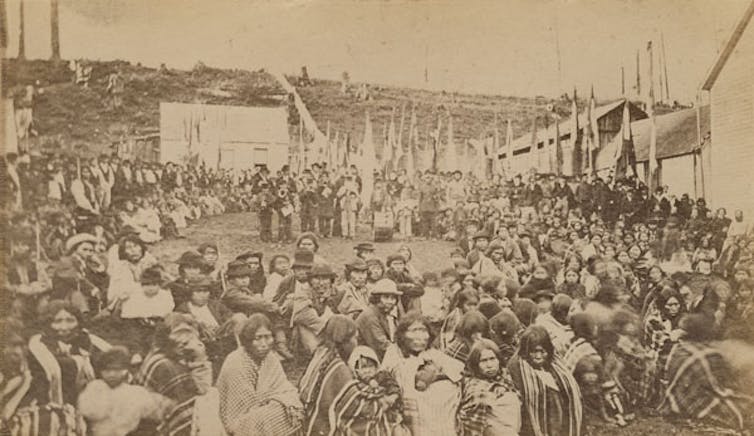
Recent years have seen Indigenous land rights protests and assertions of sovereignty across Canada. In the wake of these events, many have been learning about and coming to terms with Canada’s treatment of Indigenous Peoples.
However, many remain unaware of a significantly damaging period in Canada’s history. The “blackout” period in Aboriginal law in Canada was a time when the Canadian government in effect banned lawyers from representing Indigenous peoples.
In 1927, the federal government introduced Section 141 into the Indian Act. It banned the solicitation or collection of funds to pursue a legal claim on behalf of an Indigenous person or group without the permission of the Department of Indian Affairs.
As former prime minister John Diefenbaker explained, the provision “provide[d] that Indians can have no recourse to the courts unless they have the permission of the minister to proceed.” The blackout period lasted almost 25 years until 1951, when Section 141 was finally repealed.
While the racist and unjust nature of Section 141 is now recognized, the specific impacts of the ban have not been studied. There is still a need to shine light on this dark period of Canadian legal history, including what it meant for Indigenous Peoples and for the development of Aboriginal rights.
Denying Indigenous rights
Indigenous assertions of jurisdiction in Canada are not new. In fact, the ban on legal counsel was a response to legal campaigns by Indigenous groups that had gained momentum in the 1920s.
Organizations like the Allied Indian Tribes of British Columbia, the Nisga’a Land Committee, the Six Nations Confederacy and the League of Indians of Canada were all using the legal system as part of their political strategy. That included hiring lawyers to advance their claims to land and recognition of their inherent sovereignty.
Section 141 was added next to the Potlatch provisions that prohibited and curtailed collective gatherings including rituals and dances. Together they were a set of tools designed to control Indigenous Peoples.

First passed in 1884, they were initially sporadically enforced. But by 1914, the government had become concerned with Indigenous assertions of jurisdiction in the face its efforts to access lands for settlement and commercial development.
Through the 1920s, Indian agents and police undertook a wave of potlatch arrests, prosecutions and incarcerations. This hampered the ability of groups to hold meetings in support of land claims. At the same time, the potlatch provisions were expanded to the point where Indian agents could convict Indigenous individuals for virtually any gathering, not only traditional potlatch ceremonies.
Indigenous legal challenges
As political science professor Paul Tennant points out, by this time legal agitation by Indigenous groups had intensified to a point where they became a central frustration of the federal government. The Department of Indian Affairs saw Indigenous assertions of jurisdiction as a disruption to the operation of colonial administration and aims of assimilation.

At the international level, the Canadian government had been embarrassed by the legal agitation of the Six Nations Confederacy led by Chief Deskeheh. The Six Nations had hired lawyers in Canada and the U.S. as part of its campaign for sovereignty. Lawyers representing the Six Nations appeared before House of Commons committees and presented petitions asking the Supreme Court of Canada to consider the question of Indigenous sovereignty.
After finding no success domestically, the Six Nations petitioned the League of Nations beginning in 1922 (also without success) to recognize Canada’s failure to live up to its historic treaty agreements.
Back in Canada, the Nisga'a Land Committee and the Allied Tribes of British Columbia were mobilizing for land claims. In 1926, the Allied Tribes petitioned Parliament to allow them to bring a claim to the Privy Council for Aboriginal title for the whole province of British Columbia.
The government set up a Special Committee of the Senate and House of Commons to inquire into their claim. During the hearings, lawyers for Indigenous claimants made arguments for Aboriginal title based on legal precedents, but the committee disregarded those arguments. Instead, its findings reflect a government frustrated with Indigenous use of the legal system.
Far from considering the request, the committee found that the Allied Tribes were engaged in agitation and had wasted the government’s time with “irrelevant issues.” It recommended that all future Aboriginal land claims be refused.
Shortly after the committee made this recommendation, Parliament added Section 141 to the Indian Act. In introducing the amendment, Charles Stewart, then minister of interior, stated that the purpose was to stop lawyers from taking advantage of Indigenous groups by charging high fees for cases they could not win: “We think it is to the advantage of the Indians that these contracts be scrutinized by the department to protect them from exploitation”.
However, it is clear this was not the real concern. Section 141 was introduced specifically to limit the ability of Indigenous peoples to act within the legal system. If the intent had been to prevent outsiders from taking advantage, the provision would have applied to persons who were not “Indians.” Instead, it applied to “every person” Indian and non-Indian alike.
The intent of Section 141 was clear: “To prevent all land claim activity.”
Amy Swiffen receives funding from the Social Sciences and Humanities Research Council of Canada.
This article was originally published on The Conversation. Read the original article.







